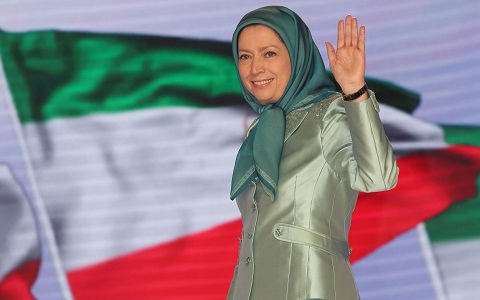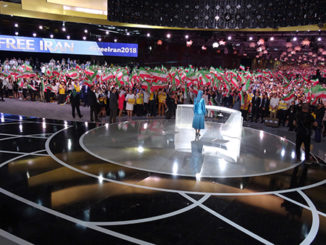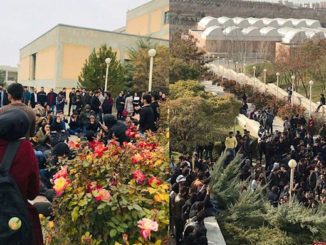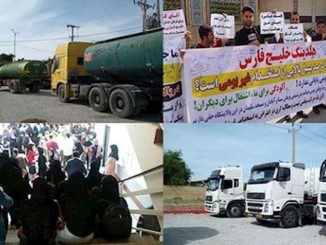
By Mahdavi nasim
At the beginning of 2018, Iran witnessed a main uprising during the ruling mullahs’ era. People clearly chanted the slogan of death to the dictator specifically referring to Khamenei, the supreme leader.
The Iranian society, which is engaged in a dire economic strongly hates the ruling regime and has the potential and readiness to overthrow the regime.
In July 2017, Mrs. Maryam Rajavi, the elected president of the NCRI, said Regime change was within reach. But at that time, for some analysts, who thought they had trustworthy intelligence from the Iranian community, what Maryam Rajavi uttered appeared to be unrealistic.
Click here for the full text of the lecture


Three fundamental truths
The light of change is shining on Iran. The ruling regime is in disarray and paralyzed as never before. Iranian society is simmering with discontent and the international community is finally getting closer to the reality that appeasing the ruling theocracy is misguided. These intense circumstances speak to three fundamental truths related to obtaining freedom and liberty in Iran, as well as peace and tranquility in the region: First, the overthrow of the ruling religious dictatorship is an imperative. Second, the regime’s overthrow is within reach. And third, a democratic alternative and an organized resistance exists, which is capable of toppling the theocracy in Iran.
Regime change, the only solution
Now, what do these mean? The first truth answers the question “what must be done regarding a regime that has held Iran and all Iranians in chains and is the driver behind war and carnage in the region”?
Is this regime really capable of reform? The answer is NO, because claimants of reform were in power for 20 years out of the 38 years of the regime’s rule, and they accomplished nothing but serving the Velayat-e Faqih regime. Would giving concessions to the regime ever lead to its change of behavior? The answer is NO. This is something that has already been tested repeatedly for the past three decades by the US and Europe. Finally, is it possible to contain this regime? NO, because what has been described as a policy of containment in effect does nothing but obstruct the path towards the adoption of a firm policy against the regime. Therefore, the conclusion is what the Iranian Resistance has emphasized since the outset and many in the world have reached today: The solution, the only solution, is regime change.
The greatest threat to the regime: The revolts waiting to erupt across Iran
The second truth is that the regime’s overthrow is possible and within reach, because the regime is besieged by extensive social discontent. As one of the commanders of the State Security Force has acknowledged, nearly 11,000 protests and demonstrations took place in Iran last year. Consider “grave dwellers,” the 10 million unemployed, the 20 million shanty-town dwellers and the 30 percent of the population who are starving. The mullahs are encircled by these very people. The hand-picked candidates for the sham presidential election admitted that this regime belongs to 4 percent of the population while 96 percent of the people despise it. Indeed, despite the regime’s deafening propaganda, the greatest threat to the regime is not a foreign enemy, but social revolts waiting to erupt within Iran itself. The reality is that the overthrow of the religious dictatorship is possible and within reach because of the regime’s ineptitude and failures, including its inability to contain the country’s economic disintegration and environmental disasters, the failure to provide for the most basic needs of our enraged people, its inability to obtain nuclear weapons, and even its failure to consolidate the regime. Regime change is within reach because the mullahs find themselves stuck in three wars of attrition in the Middle East. Their withdrawal from these conflicts in whatever form or shape will undermine their own existence.
Today, Mrs. Rajavi’s statement has been well proven and it is clear that she has had enough experience resulted of several decades of struggle against the mullahs, as well as an accurate analysis of the conditions and Iran society. So that those who are eager to know the difference between the 2018 protests from 2009’s,Must hear this from Mrs. Rajavi. She recently explained the topic very well in a piece, published on the Wall Street Journal, saying:

The protests in Iran send a cogent message: The clerical regime stands on shaky ground, and the Iranian people are unwavering in their quest to bring it down. Slogans against velayat-e faqih, or absolute clerical rule, called for a real republic and explicitly targeted the regime’s Supreme Leader Ali Khamenei and President Hassan Rouhani. This dispels the myth, still harbored by some governments that Iranians distinguish between moderates and hard-liners in Tehran. It also undercuts flawed arguments depicting a stable regime.
Millions of Iranians live in poverty. Yet Tehran has spent upward of $100 billion on the massacre in Syria, according to reports obtained by the National Council of Resistance of Iran. The chants of “Death to Hezbollah” and “Leave Syria, think about us instead” clearly demonstrate the people’s opposition to the regime’s belligerent regional schemes.
The country’s official budget this year allocates more than $26.8 billion to military and security affairs and the export of terrorism. This is in addition to the $27.5 billion in military spending from institutions controlled by Mr. Khamenei and the Islamic Revolutionary Guard Corps. The budget for health care is a mere $16.3 billion. Weak and vulnerable, the regime spends such astronomical sums on regional meddling as part of its strategy for survival.
Skeptics might point out that Iran has faced protests before. What makes the current uprising different from the 2009 protests?
The 2009 protests were sparked by rifts at the top of the regime. The current protests—which began in Iran’s second-largest city of Mashhad and quickly spread across the country—were motivated by rising prices, economic ruin, widespread corruption and resentment toward the regime. This systemic economic mismanagement has its roots in the political system, and it grows worse every day. That is why the demand for regime change surfaced almost immediately. It seems to be the only conceivable outcome.
Another major difference: The 2009 uprising was initially led by the upper middle class, with university students at its core and Tehran as its center. The recent demonstrations span a much broader swath of the population—the middle class, the underprivileged, workers, students, women and young people. Nearly all of society has been represented on the picket line.
Nor is the current uprising tied to any of the regime’s internal factions or groupings. There are no illusions about reform or gradual change from within. One of the popular slogans in Tehran is “Hard-liners, reformers, the game is now over.” This is yet another sign of the certainty of overthrow. As an Iranian expression goes: Maybe sooner or later, but definitely certain.
The final differentiating factor is the pace of events. In less than 24 hours, the protesters’ slogans shifted from economic woes to rejection of the entire regime.
The establishment has been caught off guard and is scrambling to find a unified solution. The IRGC declared victory over the protests on Sunday, but this reflects its hopes more than the reality on the ground.
The regime has issued strong warnings against joining the leading opposition group, Mujahedin-e Khalq. One after another, low-ranking and senior officials, joined by the Friday prayer leaders across the country who toe the regime’s line, blame the MEK for the protests. The torrent of statements by regime officials reflect their panic at the expansion of the nationwide uprising and the rising popularity of the MEK and the National Council of Resistance of Iran.




